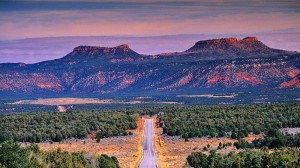If you get a cut, it very likely will heal.
If you cut a femoral artery, you may bleed to death in minutes.
A forest fire may not destroy a woodland.
But development and coal and gas and uranium mining surely will destroy a woodland and all that is seen above and exists below the surface that has existed for hundreds and thousands of years, never to be restored, and dead to us forever.
Teddy Roosevelt, a rough rider, and a lifelong Republican, discovered nature in the Dakota Badlands.
In 1888, he wrote “the time has come to inquire seriously what will happen when our forests are gone, when the coal, the iron, the oil, and the gas are exhausted, when the soils have still further been impoverished and washed into the streams, polluting the rivers, denuding the fields and obstructing navigation.”
In 1905, President Roosevelt created the United States Forest Service, and after that, 150 national forests, 51 federal bird reserves, 4 national game preserves, 5 national parks, and 18 national monuments.
The American Antiquities Act became law in 1906 and protected 230 million acres of public land because the Act gave the President the discretion to create national monuments – and he did.
After camping in Yosemite National Park, Roosevelt said, “It was like lying in a great solemn cathedral, far vaster and more beautiful than any built by the hand of man.”
Jim Wine, an acknowledged conservationist, now living in Stockholm, relies on the early legal doctrine of “usufructus” to state our legal obligation, a right to use the land (usus) in one’s lifetime, provided that its fruits (fructus) are not wasted and passed on to the next generation undiminished.
This past week, Mr. Trump violated this principle in a massive assault on protected public lands, two magnificent monuments in Utah, Bears Ears, and the Grand Staircase-Escalante.
Mr. Trump preferred the interest of large development and fossil fuel and uranium miners, insiders and contributors, who got him a desk in the Oval Office.
As for these public land grabs by Trump insiders, one famous Utahn, Robert Redford, a resident for 50 years, described the existing “cultures [in Utah] that are inextricably linked to these sandstone mesas and high alpine meadows.”
Bears Ears National Monument, covering 1.35 million acres, was originally proposed by a coalition of Native American tribes – Navajo, Hopi, Zuni, Mountain Ute and Uintah Ouray Ute. They sought to protect their sacred ancestral lands, encompassing 100,000 archaeological sites, thus their native antiquities, located on a high desert plateau in southeast Utah, as a national monument.
This past Monday, Mr. Trump reduced that Bears Ears monument by 85 percent, that is, by more than a million acres, leaving the land and native dwellings, sacred grounds, artifacts and antiquities at risk to development and looting, especially in the Dark Canyon Wilderness, Cedar Mesa, and the White Canyon.
On a second site, the nearby Grand Staircase-Escalante National Monument, Mr. Trump reduced that monument by 45 percent.
Mr. Redford said, “I honestly believe there is a moral obligation to set aside some pieces of this country and keep them for the soul of the people. Some things should be beyond both politics and money, because they are so special.”
The argument in the ensuing court cases, the complaints already filed, will be whether any president can invoke the Antiquities Act to reduce a monument created by a predecessor’s designation.
Some past Presidents have made modest reductions to public monuments, but no one challenged those in court. It’s up to the Courts to constrain Mr. Trump’s most recent unlawful misconduct.
Mr. Trump’s past bigoted remarks against Native Americans may be invoked when considering whether Mr. Trump’s constitutionally impermissible bias constituted an abuse of his discretion under the Antiquities Act.
In the 1990s Mr. Trump, not yet a failed casino operator, paid more than a million dollars in ads to slander the members of a tribe in upstate New York. Back then Trump accused some dark-skinned Native Americans of faking their ancestry. On shock jock Don Imus’ show, Trump said, “I think I have more Indian blood than a lot of the so-called Indians that are trying to open up the reservations.”
At a recent White House event, supposed to recognize Veteran Navajo “code talkers,” in front of a portrait of President Andrew Jackson who killed and displaced Native Americans, Mr. Trump went out of his way to question the Native American origin of a possible presidential contender.
These insider land grabs and impermissible biases in public land management on the national scale put us on notice to question any governmental impulse, national or local, to ease restrictions that compromise our natural legacy, whether it’s a local residence displacing green space, or the destruction of an iconic and historic monument.

